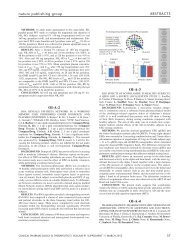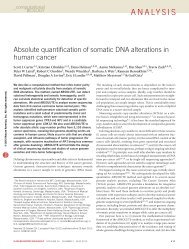open access: Nature Reviews: Key Advances in Medicine
open access: Nature Reviews: Key Advances in Medicine
open access: Nature Reviews: Key Advances in Medicine
You also want an ePaper? Increase the reach of your titles
YUMPU automatically turns print PDFs into web optimized ePapers that Google loves.
NEUROLOGY<br />
<strong>Key</strong> advances<br />
■ Apixaban is superior to warfar<strong>in</strong> <strong>in</strong><br />
reduc<strong>in</strong>g the risk of stroke or systemic<br />
embolism, and is safer <strong>in</strong> reduc<strong>in</strong>g the<br />
risk of major bleed<strong>in</strong>g or death 2<br />
■ Intracranial stent<strong>in</strong>g produces higher rates<br />
of stroke and death than an <strong>in</strong>tensive<br />
medical management strategy for severe<br />
symptomatic atherosclerotic stenosis 6<br />
■ A standardized computer algorithm for<br />
post‑process<strong>in</strong>g of MRI scans may be<br />
superior to <strong>in</strong>dividual visual estimation for<br />
select<strong>in</strong>g patients for thrombolytic therapy 8<br />
■ A comb<strong>in</strong>ation of fluoxet<strong>in</strong>e and<br />
physical therapy could produce greater<br />
improvements <strong>in</strong> limb motor function<br />
after stroke than physical therapy alone 9<br />
■ Hospitals are rapidly adopt<strong>in</strong>g stroke<br />
quality improvement registries, which<br />
could reduce mortality, cost and<br />
complications of stroke by <strong>in</strong>creas<strong>in</strong>g the<br />
use of evidence‑based therapies 10<br />
When prevention fails, acute stroke<br />
manage ment beg<strong>in</strong>s. Early reperfusion of<br />
ische mic tissue is the primary goal, which is<br />
reflec ted <strong>in</strong> the mechanism of action of the<br />
only FDA-approved therapy for improv<strong>in</strong>g<br />
stroke outcomes: tissue plasm<strong>in</strong>ogen activator.<br />
The proportion of patients who are<br />
eligible for thrombolysis, however, rema<strong>in</strong>s<br />
disappo<strong>in</strong>t<strong>in</strong>gly low, ow<strong>in</strong>g largely to the<br />
narrow time w<strong>in</strong>dow for this treatment<br />
and exclusion of patients with mild stroke.<br />
Considerable efforts have been made to<br />
develop imag<strong>in</strong>g biomarkers of the acute<br />
ischemic ‘penumbra’—bra<strong>in</strong> tissue surround<strong>in</strong>g<br />
the lesion core that is vulnerable<br />
but salvageable with early reperfusion—<strong>in</strong><br />
an attempt to expand the number of patients<br />
who can receive reperfusion therapy.<br />
Supporters of MRI-based patient selection<br />
for thrombolysis were dealt a blow<br />
3 years ago when the DIAS-2 trial 7 failed<br />
to meet its primary end po<strong>in</strong>t, as it used a<br />
widely accepted def<strong>in</strong>ition of the penum bra<br />
based on a mismatch between the volumes of<br />
ische mic bra<strong>in</strong> tissue measured on diffusion<br />
versus perfusion MRI. The MRI-mismatch<br />
approach to patient selection could be<br />
improved by the use of a standard ized computer<br />
algorithm for post-process<strong>in</strong>g of MRI<br />
scans, as suggested by a recent pooled analysis<br />
8 of the EPITHET and DEFUSE trials.<br />
The study emphasizes the importance of<br />
human error and <strong>in</strong>ter-operator variability<br />
when visual <strong>in</strong>spection, rather than automated<br />
techniques, is used to determ<strong>in</strong>e suitability<br />
for reperfusion treatment. Ongo<strong>in</strong>g<br />
trials are evaluat<strong>in</strong>g alternative strategies of<br />
MRI-based patient selection for <strong>in</strong>travenous<br />
reperfusion (MR WITNESS and EXTEND)<br />
or <strong>in</strong>tra-arterial reperfusion (MR RESCUE).<br />
Patients with acute ischemic stroke are<br />
almost always left with a degree of dis ability<br />
that requires rehabilitative treatment. Early<br />
studies suggested that constra<strong>in</strong>t therapy<br />
(immobilization of the ‘good’ arm to encourage<br />
use of the affected arm) and pharmacological<br />
stimulants could modulate bra<strong>in</strong><br />
plasticity after stroke and reduce the residual<br />
neurological deficit and subsequent disability.<br />
However, large-scale, well-designed<br />
randomized controlled trials to support these<br />
<strong>in</strong>itial f<strong>in</strong>d<strong>in</strong>gs have not been performed.<br />
Important evidence for a beneficial<br />
effect of the antidepressant fluoxet<strong>in</strong>e <strong>in</strong><br />
stroke recovery was provided <strong>in</strong> 2011 by<br />
the FLAME trial. 9 In this phase II study, all<br />
patients received physiotherapy, and those<br />
who were randomly assigned to the fluoxet<strong>in</strong>e<br />
group showed significantly greater<br />
improvement <strong>in</strong> motor function of the<br />
affected arm and leg at 90 days poststroke<br />
than did those assigned to the placebo<br />
group. Interest<strong>in</strong>gly, differences between<br />
the study groups were still signifi cant after<br />
adjustment for depression or thrombolytic<br />
use, sug gest<strong>in</strong>g that fluoxet<strong>in</strong>e could<br />
be beneficial across many subgroups. The<br />
f<strong>in</strong>d<strong>in</strong>gs, which need to be confirmed <strong>in</strong><br />
larger trials, hold promise for thousands of<br />
stroke survivors who may benefit from this<br />
and other re covery strategies to facilitate<br />
bra<strong>in</strong> plasticity.<br />
With mount<strong>in</strong>g pressure on fund<strong>in</strong>g and<br />
resources <strong>in</strong> the current economic downturn,<br />
efficient health-care delivery is becom<strong>in</strong>g<br />
<strong>in</strong>creas<strong>in</strong>gly important. The Ameri can<br />
Heart Association’s ‘Get with The Guidel<strong>in</strong>es®-Stroke’<br />
(GWTG-Stroke) quality<br />
improve ment registry tracks characteristics,<br />
performance measures, and <strong>in</strong>-hospital outcomes<br />
<strong>in</strong> nearly 2 million patients admitted<br />
to almost 2,000 US hospitals with stroke or<br />
transient ischemic attack, and provides valuable<br />
<strong>in</strong>formation on the effectiveness and<br />
safety of care delivery. 10 This registry has<br />
played a vital part <strong>in</strong> the def<strong>in</strong>i tion, assessment<br />
and validation of hospital performance<br />
metrics that have become the standard for<br />
measur<strong>in</strong>g stroke-care quality. The latest<br />
GWTG-Stroke study 10 suggests that although<br />
<strong>in</strong>-hospital mortality may be lower at registry<br />
sites, the results are largely generalizable to<br />
patients <strong>in</strong> non-registry hospitals. The measures<br />
def<strong>in</strong>ed by GWTG-Stroke are among<br />
the first to be <strong>in</strong>corporated <strong>in</strong>to a new, electronically<br />
derived set of quality measures <strong>in</strong><br />
the Mean<strong>in</strong>gful Use program, which aims to<br />
shift health records to an electronic system<br />
and def<strong>in</strong>e quality metrics <strong>in</strong> a more affordable,<br />
actionable and cost-effective manner.<br />
Strategies that seek to m<strong>in</strong>imize the costly<br />
practice of captur<strong>in</strong>g patient-level cl<strong>in</strong>ical<br />
<strong>in</strong>formation while maximiz<strong>in</strong>g the use of<br />
more cost-effective, adm<strong>in</strong>istratively derived<br />
health records are likely to form the backbone<br />
of future quality improvement efforts.<br />
Together, the advances described above<br />
reflect progress across the spectrum of stroke<br />
care (Figure 1). From novel drug or device<br />
development to new uses for approved drugs,<br />
every step forward takes us closer to the ultimate<br />
goal of better outcomes at lower cost for<br />
patients with stroke and their families.<br />
Department of Neurology-ACC 720, Harvard<br />
Medical School, Massachusetts General<br />
Hospital, 55 Fruit Street, Boston, MA 02114,<br />
USA.<br />
lschwamm@partners.org<br />
Compet<strong>in</strong>g <strong>in</strong>terests<br />
The author declares no compet<strong>in</strong>g <strong>in</strong>terests.<br />
1. Schwamm, L. H. et al. Recommendations for<br />
the establishment of stroke systems of care:<br />
recommendations from the American Stroke<br />
Association’s Task Force on the Development<br />
of Stroke Systems. Circulation 111,<br />
1078–1091 (2005).<br />
2. Granger, C. B. et al. Apixaban versus warfar<strong>in</strong> <strong>in</strong><br />
patients with atrial fibrillation. N. Engl. J. Med.<br />
365, 981–992 (2011).<br />
3. Diener, H.‑C. et al. Dabigatran compared with<br />
warfar<strong>in</strong> <strong>in</strong> patients with atrial fibrillation and<br />
previous transient ischemic attack or stroke.<br />
Lancet Neurol. 9, 1157–1163 (2010).<br />
4. Patel, M. R. et al. Rivaroxaban versus warfar<strong>in</strong><br />
<strong>in</strong> nonvalvular atrial fibrillation. N. Engl. J. Med.<br />
365, 883–891 (2011).<br />
5. Chimowitz, M. I. et al. Comparison of warfar<strong>in</strong><br />
and aspir<strong>in</strong> for symptomatic <strong>in</strong>tracranial arterial<br />
stenosis. N. Engl. J. Med. 352, 1305–1316<br />
(2005).<br />
6. Chimowitz, M. I. et al. Stent<strong>in</strong>g versus<br />
aggressive medical therapy for <strong>in</strong>tracranial<br />
arterial stenosis. N. Engl. J. Med. 365,<br />
993–1003 (2011).<br />
7. Hacke, W. et al. Intravenous desmoteplase <strong>in</strong><br />
patients with acute ischaemic stroke selected<br />
by MRI perfusion–diffusion weighted imag<strong>in</strong>g or<br />
perfusion CT (DIAS‑2): a prospective,<br />
randomised, double‑bl<strong>in</strong>d, placebo‑controlled<br />
study. Lancet Neurol. 8, 141–150 (2009).<br />
8. Lansberg, M. G. et al. RAPID automated patient<br />
selection for reperfusion therapy: a pooled<br />
analysis of the Echoplanar Imag<strong>in</strong>g<br />
Thrombolytic Evaluation Trial (EPITHET) and the<br />
Diffusion and Perfusion Imag<strong>in</strong>g Evaluation for<br />
Understand<strong>in</strong>g Stroke Evolution (DEFUSE)<br />
study. Stroke 42, 1608–1614 (2011).<br />
9. Chollet, F. et al. Fluoxet<strong>in</strong>e for motor recovery<br />
after acute ischaemic stroke (FLAME):<br />
a randomised placebo‑controlled trial. Lancet<br />
Neurol. 10, 123–130 (2011).<br />
10. Reeves, M. J. et al. Representativeness of the<br />
Get With The Guidel<strong>in</strong>es‑Stroke Registry:<br />
comparison of patient and hospital<br />
characteristics among medicare beneficiaries<br />
hospitalized with ischemic stroke. Stroke<br />
http://dx.doi.org/10.1161/<br />
STROKEAHA.111.626978.<br />
S56 | JANUARY 2012 www.nature.com/reviews








